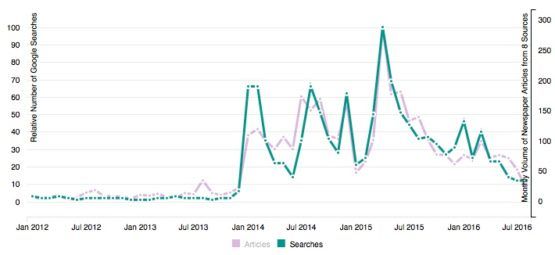Link Between Media Attention to Drought and Household Water Savings
Published on by Water Network Research, Official research team of The Water Network in Academic
With a new web-scraping and search algorithm and real water utility data, Stanford researchers have shown a relationship between media coverage of the recent historic California drought and household water savings.

With increased drought coverage from newspapers, water conservation increased in the San Francisco Bay Area during the drought that ended in 2016. That’s according to a new study from Stanford researchers that links real water consumption data with the public attention garnered by California’s recent droughts.
“A number of water utilities that we work with observed unprecedented and unexpected water conservation levels during the recent drought in California compared to previous ones,” said hydrologist Newsha Ajami, who directs Urban Water Policy and Innovation research for Stanford’s Water in the West program.
“We were curious to see what was prompting this level of public response, especially before the 2015 conservation mandate went into effect.” Ajami wondered if the heightened news coverage of the most recent drought might explain some of this behavior.
In an attempt to answer those questions, graduate student Kim Quesnel worked with Ajami to develop models examining conservation in different water districts throughout the Bay Area.
She also worked with a team to develop a search algorithm to quantify drought coverage by state and national news outlets. The group’s results, published Oct. 25 in the journal Science Advances, show the relationship between media coverage and water savings, in some cases at the level of household smart meters.
In California, water has long been a vital political and practical problem. California’s vast agriculture industry requires irrigation for crops and drinking water for livestock; at the same time, growing cities need water for drinking, washing, and landscaping. Results from this study could help the state realize the importance of encouraging water efficiency and conservation.
The power of online tools
The research team created a novel web-scraping and search algorithm, nicknamed Articulate, to quantify the drought-related coverage from nine major national and California-based newspapers between 2005 and 2015. This period encompassed the majority of the two most recent California droughts in 2007-2009 and 2011-2016.
They compared their algorithm’s results with Google Trends, a free online tool that showed the number of drought-related searches performed by Bay Area residents. The level of media attention to drought conditions closely matched the fluctuations in the public’s awareness and curiosity.

With increased media coverage of the drought (pink lines), web searches for drought information also increased (green lines). (Image credit: Urban Water Policy and Innovation team)
The first drought period saw barely any publicity or increased web searches. “There were other things on people’s minds,” said Quesnel, referring to a historic election season and the Great Recession, both of which dominated media coverage at the time. The second drought, however, generated hundreds of news articles per month describing dry conditions, historic mandatory water conservation measures and rising water prices statewide.
Quesnel compared the water demands of single-family households in the Bay Area to factors including unemployment, weather, household income and, of course, media coverage. From her models, she found that economic hardship from the high unemployment rates during the Great Recession correlated with water savings during the first drought. In both droughts, higher summer temperatures corresponded to higher seasonal water use.
Strikingly, their models also found that for every 100-article increase over a two-month period, there was an 11 percent to 18 percent decrease in demand for water. With an enormous spike in media attention during the second drought, water savings across all studied areas were dramatic.
Read full article: Stanford
Media
Taxonomy
- Resource Management
- Drought
- Water Supply
- Urban Resource Management
- Community Supply
- Consumption
- Water Resource Management